翻译理论与实践复件
- 格式:doc
- 大小:525.54 KB
- 文档页数:44
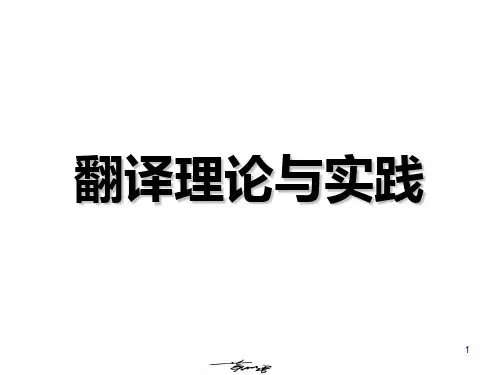
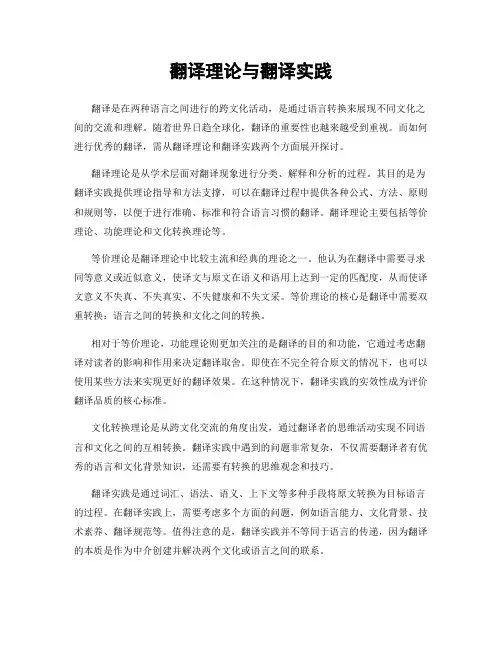
翻译理论与翻译实践翻译是在两种语言之间进行的跨文化活动,是通过语言转换来展现不同文化之间的交流和理解。
随着世界日趋全球化,翻译的重要性也越来越受到重视。
而如何进行优秀的翻译,需从翻译理论和翻译实践两个方面展开探讨。
翻译理论是从学术层面对翻译现象进行分类、解释和分析的过程。
其目的是为翻译实践提供理论指导和方法支撑,可以在翻译过程中提供各种公式、方法、原则和规则等,以便于进行准确、标准和符合语言习惯的翻译。
翻译理论主要包括等价理论、功能理论和文化转换理论等。
等价理论是翻译理论中比较主流和经典的理论之一。
他认为在翻译中需要寻求同等意义或近似意义,使译文与原文在语义和语用上达到一定的匹配度,从而使译文意义不失真、不失真实、不失健康和不失文采。
等价理论的核心是翻译中需要双重转换:语言之间的转换和文化之间的转换。
相对于等价理论,功能理论则更加关注的是翻译的目的和功能,它通过考虑翻译对读者的影响和作用来决定翻译取舍。
即使在不完全符合原文的情况下,也可以使用某些方法来实现更好的翻译效果。
在这种情况下,翻译实践的实效性成为评价翻译品质的核心标准。
文化转换理论是从跨文化交流的角度出发,通过翻译者的思维活动实现不同语言和文化之间的互相转换。
翻译实践中遇到的问题非常复杂,不仅需要翻译者有优秀的语言和文化背景知识,还需要有转换的思维观念和技巧。
翻译实践是通过词汇、语法、语义、上下文等多种手段将原文转换为目标语言的过程。
在翻译实践上,需要考虑多个方面的问题,例如语言能力、文化背景、技术素养、翻译规范等。
值得注意的是,翻译实践并不等同于语言的传递,因为翻译的本质是作为中介创建并解决两个文化或语言之间的联系。
一个好的翻译需要翻译者结合翻译理论和翻译实践进行切实可行的操作。
因此,好的翻译一定是理论和实践相结合、以实际效果为导向的翻译。
翻译者需要通过翻译理论来指导自己的翻译实践,同时在实际操作中总结出适合自身的方法和技巧。
值得一提的是,翻译理论和翻译实践是相互交织着的。
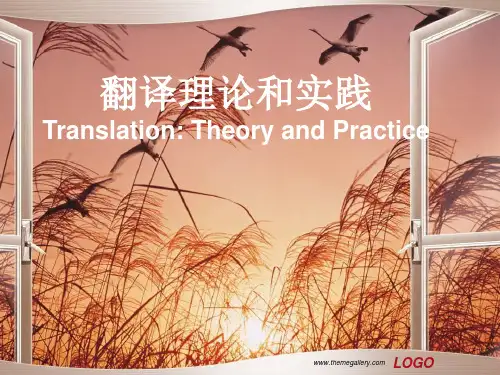
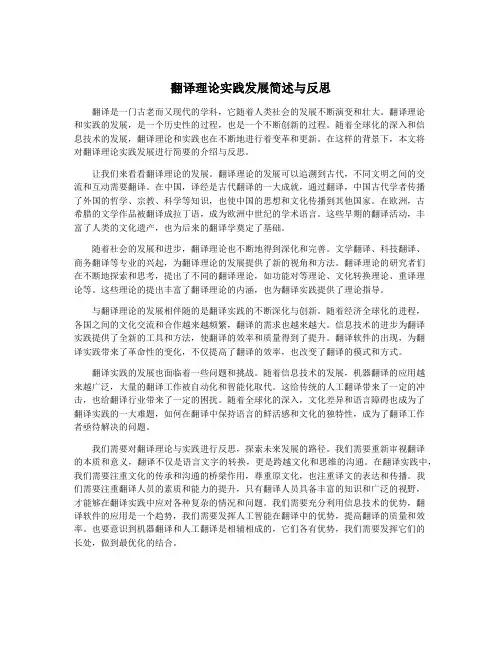
翻译理论实践发展简述与反思翻译是一门古老而又现代的学科,它随着人类社会的发展不断演变和壮大。
翻译理论和实践的发展,是一个历史性的过程,也是一个不断创新的过程。
随着全球化的深入和信息技术的发展,翻译理论和实践也在不断地进行着变革和更新。
在这样的背景下,本文将对翻译理论实践发展进行简要的介绍与反思。
让我们来看看翻译理论的发展。
翻译理论的发展可以追溯到古代,不同文明之间的交流和互动需要翻译。
在中国,译经是古代翻译的一大成就,通过翻译,中国古代学者传播了外国的哲学、宗教、科学等知识,也使中国的思想和文化传播到其他国家。
在欧洲,古希腊的文学作品被翻译成拉丁语,成为欧洲中世纪的学术语言。
这些早期的翻译活动,丰富了人类的文化遗产,也为后来的翻译学奠定了基础。
随着社会的发展和进步,翻译理论也不断地得到深化和完善。
文学翻译、科技翻译、商务翻译等专业的兴起,为翻译理论的发展提供了新的视角和方法。
翻译理论的研究者们在不断地探索和思考,提出了不同的翻译理论,如功能对等理论、文化转换理论、重译理论等。
这些理论的提出丰富了翻译理论的内涵,也为翻译实践提供了理论指导。
与翻译理论的发展相伴随的是翻译实践的不断深化与创新。
随着经济全球化的进程,各国之间的文化交流和合作越来越频繁,翻译的需求也越来越大。
信息技术的进步为翻译实践提供了全新的工具和方法,使翻译的效率和质量得到了提升。
翻译软件的出现,为翻译实践带来了革命性的变化,不仅提高了翻译的效率,也改变了翻译的模式和方式。
翻译实践的发展也面临着一些问题和挑战。
随着信息技术的发展,机器翻译的应用越来越广泛,大量的翻译工作被自动化和智能化取代。
这给传统的人工翻译带来了一定的冲击,也给翻译行业带来了一定的困扰。
随着全球化的深入,文化差异和语言障碍也成为了翻译实践的一大难题,如何在翻译中保持语言的鲜活感和文化的独特性,成为了翻译工作者亟待解决的问题。
我们需要对翻译理论与实践进行反思,探索未来发展的路径。
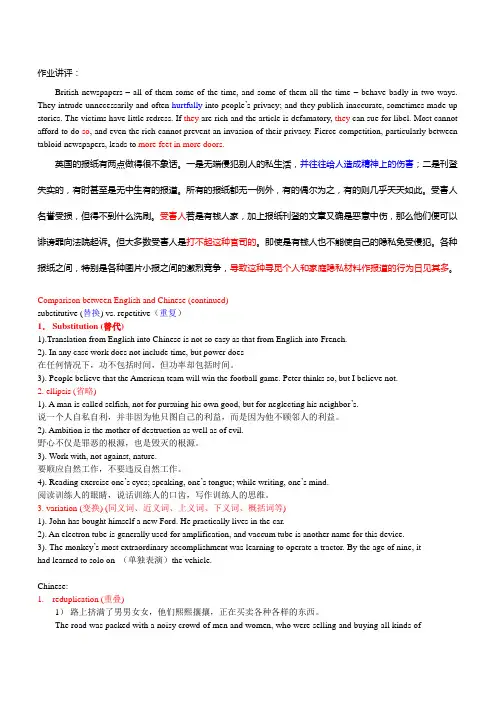
作业讲评:British newspapers – all of them some of the time, and some of them all the time – behave badly in two ways. They intrude unnecessarily and often hurtfully into people’s privacy; and they publish inaccurate, sometimes made-up stories. The victims have little redress. If they are rich and the article is defamatory, they can sue for libel. Most cannot afford to do so, and even the rich cannot prevent an invasion of their privacy. Fierce competition, particularly between tabloid newspapers, leads to more feet in more doors.英国的报纸有两点做得很不象话。
一是无端侵犯别人的私生活,并往往给人造成精神上的伤害;二是刊登失实的,有时甚至是无中生有的报道。
所有的报纸都无一例外,有的偶尔为之,有的则几乎天天如此。
受害人名誉受损,但得不到什么洗刷。
受害人若是有钱人家,加上报纸刊登的文章又确是恶意中伤,那么他们便可以诽谤罪向法院起诉。
但大多数受害人是打不起这种官司的。
即使是有钱人也不能使自己的隐私免受侵犯。
各种报纸之间,特别是各种图片小报之间的激烈竞争,导致这种寻觅个人和家庭隐私材料作报道的行为日见其多。
Comparison between English and Chinese (continued)substitutive (替换) vs. repetitive(重复)1.Substitution (替代)1).Translation from English into Chinese is not so easy as that from English into French.2). In any case work does not include time, but power does在任何情况下,功不包括时间,但功率却包括时间。
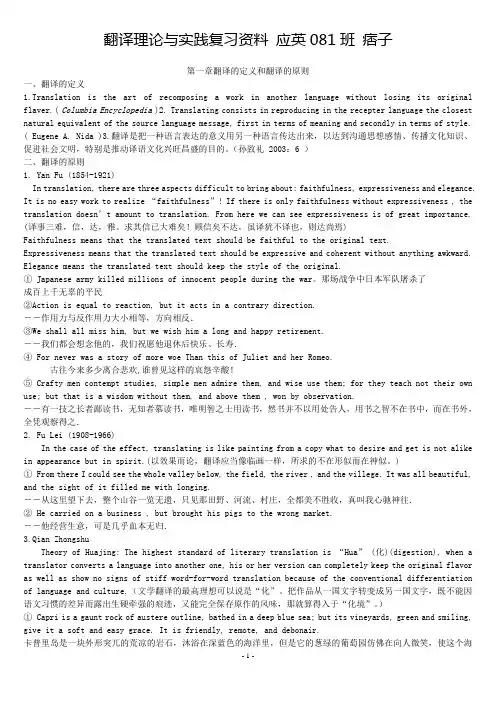
翻译理论与实践复习资料应英081班痞子第一章翻译的定义和翻译的原则一、翻译的定义1.Translation is the art of recomposing a work in another language without losing its original flaver.( Columbia Encyclopedia)2. Translating consists in reproducing in the recepter language the closest natural equivalent of the source language message, first in terms of meaning and secondly in terms of style. ( Eugene A. Nida )3.翻译是把一种语言表达的意义用另一种语言传达出来,以达到沟通思想感情、传播文化知识、促进社会文明,特别是推动译语文化兴旺昌盛的目的。
(孙致礼 2003:6 )二、翻译的原则1. Yan Fu (1854-1921)In translation, there are three aspects difficult to bring about: faithfulness, expressiveness and elegance. It is no easy work to realize “faithfulness”! If there is only faithfulness without expressiveness , the translation doesn’t amount to translation. From here we can see expressiveness is of great importance. (译事三难,信,达,雅。
求其信已大难矣!顾信矣不达,虽译犹不译也,则达尚焉)Faithfulness means that the translated text should be faithful to the original text.Expressiveness means that the translated text should be expressive and coherent without anything awkward. Elegance means the translated text should keep the style of the original.① Japanese army killed millions of innocent people during the war。
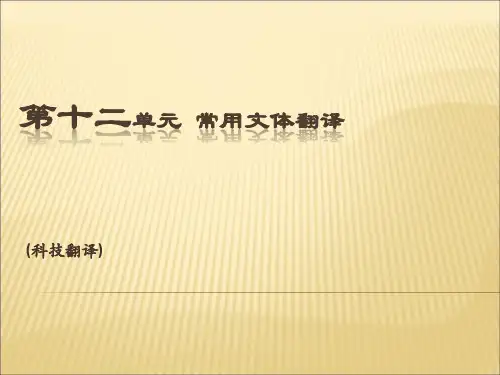
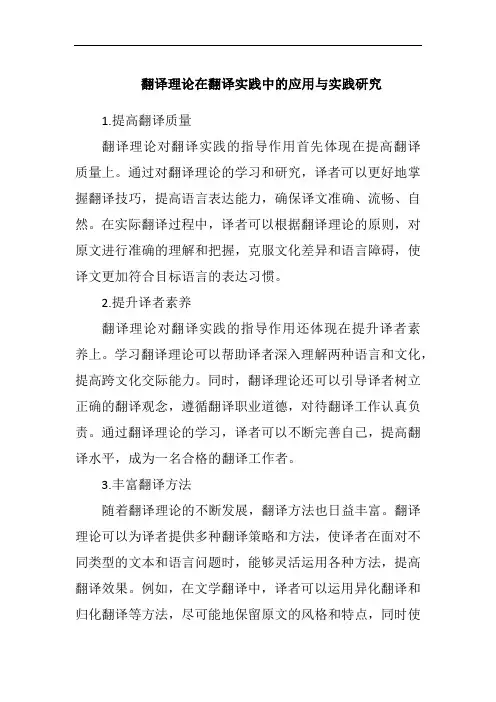
翻译理论在翻译实践中的应用与实践研究1.提高翻译质量翻译理论对翻译实践的指导作用首先体现在提高翻译质量上。
通过对翻译理论的学习和研究,译者可以更好地掌握翻译技巧,提高语言表达能力,确保译文准确、流畅、自然。
在实际翻译过程中,译者可以根据翻译理论的原则,对原文进行准确的理解和把握,克服文化差异和语言障碍,使译文更加符合目标语言的表达习惯。
2.提升译者素养翻译理论对翻译实践的指导作用还体现在提升译者素养上。
学习翻译理论可以帮助译者深入理解两种语言和文化,提高跨文化交际能力。
同时,翻译理论还可以引导译者树立正确的翻译观念,遵循翻译职业道德,对待翻译工作认真负责。
通过翻译理论的学习,译者可以不断完善自己,提高翻译水平,成为一名合格的翻译工作者。
3.丰富翻译方法随着翻译理论的不断发展,翻译方法也日益丰富。
翻译理论可以为译者提供多种翻译策略和方法,使译者在面对不同类型的文本和语言问题时,能够灵活运用各种方法,提高翻译效果。
例如,在文学翻译中,译者可以运用异化翻译和归化翻译等方法,尽可能地保留原文的风格和特点,同时使译文符合目标语言的表达习惯。
4.促进翻译评价体系的完善翻译理论对翻译实践的指导作用还可以体现在促进翻译评价体系的完善上。
翻译理论可以为译者提供评价译文质量的标准和方法,使译者在翻译过程中有据可依,提高翻译质量。
同时,翻译理论还可以帮助翻译评审者和读者更好地评价译文的质量,确保翻译工作的公平、公正、公开。
总之,翻译理论在翻译实践中的应用与实践研究具有重要意义。
翻译理论对翻译实践具有指导作用,可以提高翻译质量、提升译者素养、丰富翻译方法和促进翻译评价体系的完善。
因此,译者应当重视翻译理论的学习和研究,将翻译理论运用到实际翻译工作中,不断提高自己的翻译水平,为我国翻译事业的发展做出贡献。
同时,翻译理论研究者也应关注翻译实践,结合实际翻译问题,不断丰富和发展翻译理论,为翻译实践提供更有针对性和实用性的指导。
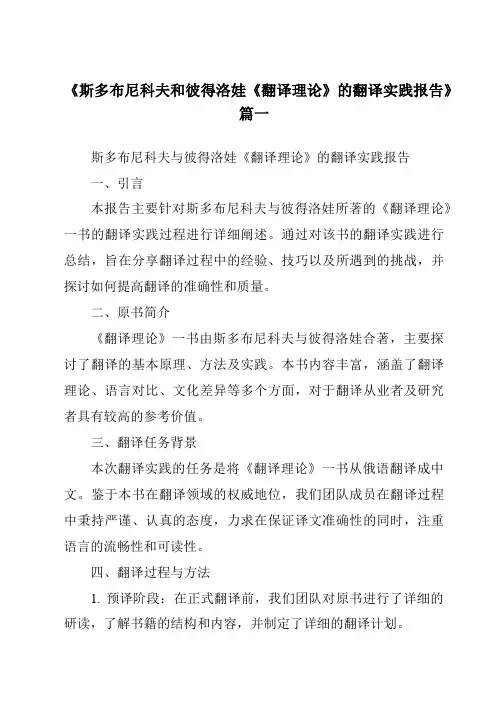
《斯多布尼科夫和彼得洛娃《翻译理论》的翻译实践报告》篇一斯多布尼科夫与彼得洛娃《翻译理论》的翻译实践报告一、引言本报告主要针对斯多布尼科夫与彼得洛娃所著的《翻译理论》一书的翻译实践过程进行详细阐述。
通过对该书的翻译实践进行总结,旨在分享翻译过程中的经验、技巧以及所遇到的挑战,并探讨如何提高翻译的准确性和质量。
二、原书简介《翻译理论》一书由斯多布尼科夫与彼得洛娃合著,主要探讨了翻译的基本原理、方法及实践。
本书内容丰富,涵盖了翻译理论、语言对比、文化差异等多个方面,对于翻译从业者及研究者具有较高的参考价值。
三、翻译任务背景本次翻译实践的任务是将《翻译理论》一书从俄语翻译成中文。
鉴于本书在翻译领域的权威地位,我们团队成员在翻译过程中秉持严谨、认真的态度,力求在保证译文准确性的同时,注重语言的流畅性和可读性。
四、翻译过程与方法1. 预译阶段:在正式翻译前,我们团队对原书进行了详细的研读,了解书籍的结构和内容,并制定了详细的翻译计划。
2. 术语准备:针对书中涉及的专业术语和表达方式,我们进行了专门的术语表编制,确保术语的准确性和统一性。
3. 翻译实践:在翻译过程中,我们采用了直译与意译相结合的方法,力求在保持原文意思的同时,使译文更加符合中文表达习惯。
4. 校对与审稿:完成初稿后,我们进行了多次校对和审稿,以确保译文的准确性和流畅性。
五、翻译中的难点与解决策略1. 文化差异的处理:在翻译过程中,我们遇到了许多因文化差异而导致的表达方式不同的问题。
针对这些问题,我们通过查阅相关资料和请教专家,力求找到最合适的表达方式。
2. 专业术语的翻译:本书涉及大量专业术语,我们在术语表的编制和更新上下了很大功夫,以确保术语的准确性和统一性。
3. 长句翻译:原书中有许多长句,我们在翻译时采用了分段、拆句等方法,使译文更加易于理解。
六、翻译质量评估与反思我们认为本次翻译实践的质量主要体现在以下几个方面:1. 准确性:我们在翻译过程中严格遵循原文意思,力求在保持原文意思的同时,使译文更加准确。
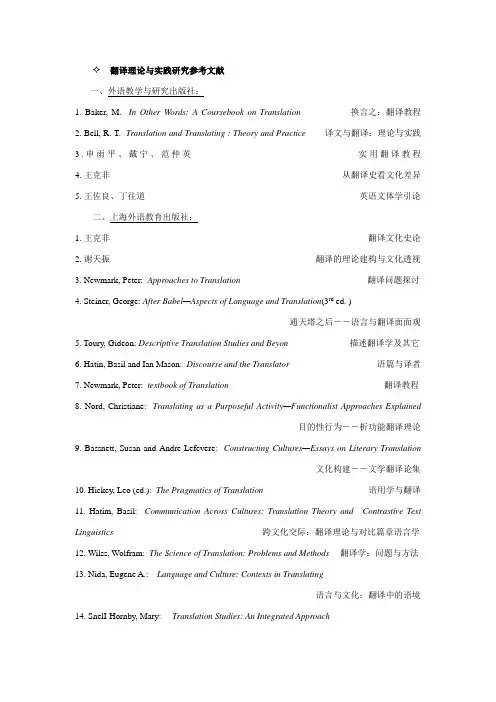
翻译理论与实践研究参考文献一、外语教学与研究出版社:1. Baker, M. In Other Words: A Coursebook on Translation 换言之:翻译教程2. Bell, R. T. Translation and Translating : Theory and Practice译文与翻译:理论与实践3.申雨平、戴宁、范仲英实用翻译教程4. 王克非从翻译史看文化差异5. 王佐良、丁往道英语文体学引论二、上海外语教育出版社:1. 王克非翻译文化史论2. 谢天振翻译的理论建构与文化透视3. Newmark, Peter: Approaches to Translation翻译问题探讨4. Steiner, George: After Babel—Aspects of Language and Translation(3rd ed. )通天塔之后――语言与翻译面面观5. Toury, Gideon: Descriptive Translation Studies and Beyon 描述翻译学及其它6. Hatin, Basil and Ian Mason: Discourse and the Translator语篇与译者7. Newmark, Peter: textbook of Translation 翻译教程8. Nord, Christiane: Translating as a Purposeful Activity—Functionalist Approaches Explained目的性行为――析功能翻译理论9. Bassnett, Susan and Andre Lefevere: Constructing Cultures—Essays on Literary Translation文化构建――文学翻译论集10. Hickey, Leo (ed.): The Pragmatics of Translation语用学与翻译11. Hatim, Basil: Communication Across Cultures: Translation Theory and Contrastive Text Linguistics跨文化交际:翻译理论与对比篇章语言学12. Wilss, Wolfram: The Science of Translation: Problems and Methods 翻译学:问题与方法13. Nida, Eugene A.:Language and Culture: Contexts in Translating语言与文化:翻译中的语境14. SnelI-Hornby, Mary: Translation Studies: An Integrated Approach翻译研究:综合法15. Davis, Kathleen: Deconstruction and Translation 解构主义与翻译16. Hermans, Thee: Translation in Systems: Descriptive and System Oriented Approaches Explained 系统中的翻译:描写和系统理论解说17. Gull, Ernst-August: Translation and Relevance Cognition and Context翻译与关联:认知与语境18. Gentzler, Edwin: Contemporary Translation Theories (revised 2nd editio)当代翻译理论(第二版)19. Baker, Mona (ed.): Routledge Encyclopedia of Translation Studies翻译研究百科全书20. Nida, Eugene A.: Toward a Science of Translating 翻译科学探索21. Nida, Eugene A. & Charles R.:The Theory and Practice of Translation翻译理论与实践22. Lefevere, Andre (ed.): Translation/History/Culture: A Sourcebook 翻译、历史与文化论集23. Reiss, Katharina: Translation Criticism: The Potentials and Limitations翻译批评:潜力与制约24. Venuti, Lawrence:The Translator's Invisibility: A History of Translation译者的隐身:一部翻译史25. Bassnett, Susan: Translation Studies (3rd edition) 翻译研究(第三版)26. Williams, Jenny & Andrew Chesterman:The Map: A Beginner's Guide to Doing Research in Translation Studies 路线图:翻译研究方法入门27. Shullleworth, Mark & Moira: Dictionary of Translation Studies翻译学词典三、中国对外翻译出版公司:翻译理论与实务丛书(罗进德主编)1. 马祖毅著中国翻译简史——五四以前部分(增订版)2. 金 著等效翻译探索 (增订版)3. 刘宓庆著文体与翻译 (增订版)4. 金圣华、黄国彬主编困难见巧——名家翻译经验谈5.周兆祥著翻译与人生6.陈生保编著英汉科技翻译指要7. 冯志杰著汉英科技翻译指要8. 陈忠诚著法窗译话9. 刘重德编著文学翻译十讲10. 陈定安编著英汉比较与翻译11. 谭载喜编著新编奈达论翻译12. 刘宓庆著当代翻译理论13. 郭建中编文化与翻译14. 陈忠诚著词语翻译丛谈15. 陈忠诚、吴幼娟著词语翻译丛谈续编16. 贾文波著汉英时文翻译17. 黄忠廉著翻译变体研究18. 马红军著翻译批评散论19.思果著翻译新究20. 李运兴著语篇翻译引论21. 包惠南著文化语境与语言翻译22. 刘宓庆著翻译与语言哲学23. 萧立明著新译学论稿四、其它:1. 《翻译论集》罗新璋编,商务印书馆,1984年版2. 《中国翻译史》(上卷) 马祖毅著,湖北教育出版社,1999年版3. 《西方翻译简史》谭载喜著,商务印书馆,1991年版4. 《外国翻译理论评介文集》中国对外翻译出版公司编印,1984年版5. 《奈达论翻译》谭载喜编译,中国对外翻译出版公司,1984年版6. 《语言与翻译》[苏]巴尔胡达罗夫著,蔡毅、虞杰、段京华编译,中国对外翻译出版公司,1985年版7. 《文体与翻译》刘宓庆著,中国对外翻译出版公司,1986年版8. 《习语汉译英研究》张培基编,商务印书馆,1979年版9. 《英汉翻译教程》张培基等编著,上海外语教育出版社,1980年版10. 《英汉翻译手册》钟述孔著,商务印书馆,1980年版11. 《翻译的技巧》钱歌川著,台湾开明书店印行,1972年版12. 《翻译漫谈》钱歌川著,中国对外翻译出版公司,1980年版13. 《科技翻译工作手册》李维颐等编,天津科学技术出版社,1986年版14. 《长安译论》王宏印主编,陕西旅游出版社,2000年版15. 《跨语交际》谭载喜编译,漓江出版社,1993年版16. 《语言论——言语研究导论》[美]爱德华·萨丕尔著,陆卓元译,商务印书馆,1997年版17. 《句法理论的若干问题》[美]诺姆·乔姆斯基著,黄长著、林书武、沈家煊译,中国社会科学出版社,1986年版18. 《意义的探究——当代西方释义学》张汝伦著,辽宁人民出版社,1986年版英汉翻译常用工具书(一)英汉类1.《新英汉词典》(增补本) 《新英汉词典》编写组编,上海译文出版社,1986年版2.《英华大辞典》(修订第二版) 郑易里等编并修订,商务印书馆,1984年版3.《英汉大辞典》(缩印本) 陆谷孙主编,上海译文出版社,1993年版4.《远东英汉大辞典》梁实秋主编,远东图书公司印行,1977年版5.《最新高级英汉词典》蔡文萦主编,李赋宁审校,商务印书馆国际有限公司,1994年版(二)汉英类1.《汉英词典》(修订版)、北京外国语大学英语系词典组编,外语教学与研究出版社,l 995年版2.《汉英大辞典》(上、下卷) 吴光华主编,上海交通大学出版社,1993年版3.《远东汉英大辞典》梁实秋原主编,张芳杰主编,新华出版社,远东图书公司,1995年版(三)英语类1.Longman Dicitonary of Contemporary Englis h,Longman Group Limited.19782.Chambers Twentieth Century Dictionary,new ed.,Edinburgh & London,1972.3.The American Heritage Dictionary of the English Language,New York.19754.Webster’s Third New International Dictionary of the English Language,Springfield,Mass.,1961(Addenda 1966),19715.6,000 words:A Supplement to Webster’s Third New International Dictionary,Springfield,Mass.,19766.ORIGINS An Etymological Dictionary of Modern Englis h,by Eric Partridge,London,1990(四)汉语类1.《现代汉语词典》商务印书馆,1970年版2.《现代汉语词林》(正反序编排) 福建人民出版社,1986年版3.《汉语大字典》(缩印本)《汉语大字典》编委会,四川辞书出版社、湖北辞书出版社,1993年版4.《古代汉语词典》《古代汉语词典》编写组,商务印书馆,1998年版(五)专名类1.《英语姓名译名手册》(第二次修订本) 新华通讯社译名资料组编,商务印书馆,1985年版2.《世界姓名译名手册》《世界姓名译名手册》编译组编,化学工业出版社,1987年版3.《外国地名译名手册》中国地名委员会编,商务印书馆,1983年版4.《世界地名译名手册》辛华编,商务印书馆,1978年版5.《世界报刊、通讯社、电台译名手册》(修订本) 辛华编,商务印书馆;1978年版(六)略语类1.《英汉缩略语词典》西安外国语学院英语系《英汉缩略语词典》编写组,陕西人民出版社,1980年版2.《英语缩略词词典》史群编,商务印书馆,1979年版(七)科技类1.《英汉技术词典》清华大学《英汉技术词典》编写组编,国防工业出版社,1978年版2.《英汉科技缩写词汇》阎庆甲编,冶金工业出版社,1981年版3.《科技翻译工作手册》李维颐等编,天津科学技术出版社,1986年版(八)史地类1.《世界历史词典》勒文翰、郭圣铭、孙道天主编,上海辞书出版社,1985年版2.《外国历史大事年表》(公元前4500年一公元1945年) 王治邦、曲培洛、唐承运、于庆和、王永本编,辽宁人民出版社,1985年版3.《世界现代史大事记》吴成平编著,知识出版社,1984年版4.《美国两百年大事记》[美]加尔文·D·林顿编著,谢延光、储复耘、容再光、李祥荣译,上海译文出版社,1984年版5.《各国概况》(1979年版) 《各国概况》编辑组编,世界知识出版社,1979年版(九)百科类1.《辞海》(缩印本) 《辞海》编辑委员会编,上海辞书出版社,1989年版2.《辞源》(修订本) (1—4合订本)商务印书馆,1989年版3.《简明不列颠百科全书》(十卷本) 《简明不列颠百科全书》编辑部译编,中国大百科全书出版社,1986年版4.《中国大百科全书》(多卷本) 中国大百科全书出版社,1982年版。
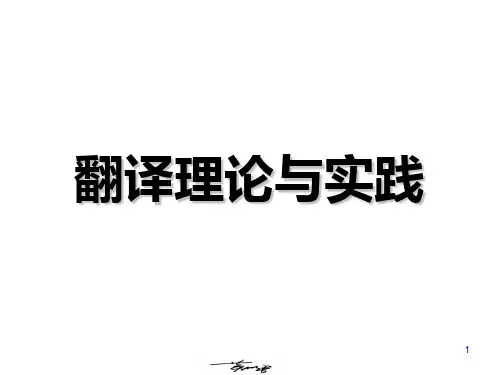
翻译实践报告范文(共7篇)翻译实践报告范文(共7篇)1. 引言 ................................................ (1)2. 翻译过程分析 ................................................ ................................................... .....2.1直译法 ................................................ ................................................... ...............2.2排比、对偶句的处理 ................................................ ..........................................2.3语序调整 ................................................ ................................................... ...........2.4成语及四字词语的处理 ......................................................................................3. 结语 ................................................ ................................................... .....................参考文献................................................. ................................................... ....................1. 引言翻译是一门艺术,一门语言的艺术。
理论与实践英语作文及翻译Theory and Practice。
Theory and practice are two essential components of learning. Theory provides us with the knowledge and understanding of a subject, while practice enables us to apply that knowledge to real-life situations. Both are equally important and complement each other in the learning process.Theoretical knowledge is the foundation of any subject. It provides us with a conceptual framework that helps us understand the subject in a structured way. For example, in the field of physics, theory helps us understand the laws of motion, gravity, and other fundamental principles. Similarly, in the field of economics, theory helps us understand the concepts of supply and demand, market equilibrium, and other economic principles.However, theoretical knowledge alone is not enough. Itneeds to be complemented with practical experience. Practice helps us apply the theoretical knowledge to real-life situations and understand the nuances of the subject. For example, in the field of medicine, doctors need to apply their theoretical knowledge to diagnose and treat patients. Similarly, in the field of engineering, engineers need to apply their theoretical knowledge to design and build structures and machines.The relationship between theory and practice is notone-way. Practice also helps to refine and improve theoretical knowledge. When we apply theoretical knowledge to real-life situations, we may encounter new challenges and problems. This can lead to the development of new theories or modifications to existing ones. For example, the development of quantum mechanics was driven by the need to explain experimental results that could not be explained by classical physics.In conclusion, theory and practice are two sides of the same coin. They are both essential components of learning and complement each other. Theoretical knowledge providesus with a conceptual framework, while practice enables usto apply that knowledge to real-life situations. Both are equally important in the learning process and help us to develop a deeper understanding of the subject.理论与实践。
校园英语 / 翻译研究试论翻译理论与实践的关系及其结合方式对外经济贸易大学/苏盼【摘要】“翻译理论与实践”是高校英语专业的一门基础课程,要获得完美的翻译效果,必须要运用翻译理论来决定采用的翻译实践类型,通过翻译实践来完成译作,要厘清两者的关系并进行有机的结合。
本文介绍了翻译理论与实践的关系以及两者的结合方式。
【关键词】翻译理论 翻译实践 关系 结合方式一、前言翻译是一种交际活动,它是不同语言、文化和社会关系的交流,翻译同时也是一门科学和艺术。
如果认为精通了一门外语再借助于字典和工具书就可以翻译,是非常片面和错误的。
要做出具有专业水平和质量的译文,必须要深入的研究原语文化。
在翻译过程中熟悉两种语言是最基本的,语言是有灵魂和生命的,要通过语言表达的信息来了解其所反映的文化,这样才能深刻体会中西文化的差异。
不同的民族都有不同的生存环境,对于世界的认识也存在着差异,这些都造成了民族文化的差异。
人们通过本民族的文化理解方式来理解周围的信息,原文的作者和读者一般来说文化背景是相似的,读者会通过词汇表达意思的理解来理解文章的文化内涵,译者根据自己的语言理解和文化前景进行翻译,表达自己的情感和对原文信息,所以纽马克说“翻译者必须是一个真正意义上的文化人”。
翻译者要精通两种语言,要通过大量的信息来了解两个语种文化的差异,这样才能找到一个契合点,才能让译者更客观的读懂原作,可以准确的把握原文的文化信息并进行传播,翻译理论和翻译实践缺一不可。
二、翻译理论与翻译实践1.翻译理论。
翻译理论的产生和发展一度呈现出百家争鸣、学派林业的局面,通过进行翻译理论的研究,更加深入了解翻译活动的本质,最初研究的是原文与译文,随着研究的深入,进行了对译文的读者、采取的翻译策略以及翻译者的心理活动等深层次的研究,通过翻译理论的日渐系统化,人们越来越重视翻译理论的研究。
比较有代表性的是英国翻译理论家彼得·纽马克的翻译理论,纽马克对翻译领域的各派系翻译理论进行了部结,在对翻译理论进行研究时融合了文体、话语分析、格语法、功能语法以及跨文化交际等理论内容,非常全面的论述了翻译理论、翻译教学和翻译技巧。
翻译实践报告中翻译理论应用的问题及对策在翻译领域,翻译实践报告是对翻译过程和成果的重要总结与反思。
其中,翻译理论的应用对于提高翻译质量、保障翻译效果具有关键作用。
然而,在实际的翻译实践报告撰写中,翻译理论的应用往往存在一些问题,需要我们认真分析并寻求有效的对策。
一、翻译理论应用存在的问题1、理论选择不当在翻译实践报告中,部分译者未能根据翻译文本的特点和要求,选择合适的翻译理论作为指导。
有些译者盲目追求热门或新颖的理论,而忽略了其与实际翻译任务的契合度;还有些译者对各种翻译理论了解不深,导致选择的理论无法有效解决翻译中遇到的问题。
2、理论理解肤浅一些译者虽然选择了相关的翻译理论,但对其理解仅停留在表面,未能深入领会理论的核心概念和原则。
这使得他们在应用理论时,无法准确把握理论的适用范围和条件,从而出现生搬硬套的情况,影响了翻译的质量和效果。
3、应用缺乏灵活性翻译理论的应用应该是灵活多变的,需要根据具体的语境和翻译目的进行调整。
但在实际操作中,部分译者过于僵化地遵循所选的翻译理论,缺乏对具体情况的分析和判断,导致翻译结果不符合目标读者的需求和期望。
4、与实践结合不紧密部分翻译实践报告中,翻译理论的应用与实际的翻译操作之间存在明显的脱节。
理论阐述与翻译案例分析之间缺乏有机的联系,无法充分展示理论是如何指导实践以及实践是如何验证理论的。
5、缺乏创新性有些译者在应用翻译理论时,缺乏创新思维,只是重复前人的研究成果和应用方法,未能在实践中对理论进行拓展和创新,无法为翻译研究和实践提供新的视角和思路。
二、解决翻译理论应用问题的对策1、深入研究翻译理论译者在进行翻译实践之前,应该对各种翻译理论进行系统、深入的学习和研究。
了解不同理论的特点、优势和适用范围,以便能够根据具体的翻译任务选择最合适的理论作为指导。
2、注重理论与实践的互动在翻译实践过程中,译者要时刻关注理论的应用效果,及时总结经验教训。
通过不断地实践和反思,加深对翻译理论的理解,提高理论应用的能力。
翻译实习报告(通用8篇)翻译实习报告 1一、实习目的实习目的是,通过英语翻译相关工作岗位实习使我了解以后再英语翻译相关工作岗位工作的特点、性质,学习体验英语翻译相关岗位工作的实际情况,学习与积累工作经验,为以后真正走上英语翻译相关工作岗位做好岗前准备。
同时通过英语翻译相关工作岗位的实习,熟悉实际工作过程的运作体系和管理流程,把自己所学英语翻译工作岗位理论知识应用于实际,锻炼英语翻译工作岗位业务能力和社会交际实践能力,并在工作中学习英语翻译相关工作岗位的新知识,对自己所学的知识进行总结并提升,以指导未来在英语翻译相关工作岗位的学习重点和发展方向。
二、实习时间03月01日~06月15日(修改成自己英语翻译相关工作岗位实习时间)三、实习地点苏州市经济开发区江南大道(修改成自己英语翻译工作岗位实习地点)四、实习单位江苏省苏杭教育集团(修改成自己英语翻译相关工作岗位实习单位)此处可以继续添加具体你英语翻译工作岗位实习单位的详细介绍五、实习主要内容我很荣幸进入江苏省苏杭教育集团(修改成自己英语翻译相关工作岗位实习单位)开展英语翻译岗位实习。
为了更好地适应从没有英语翻译岗位工作经验到一个具备完善业务水平的工作人员,实习单位主管领导首先给我们分发英语翻译相关工作岗位从业相关知识材料进行一些基础知识的自主学习,并安排专门的老前辈对英语翻译岗位所涉及的相关知识进行专项培训。
在实习过程,单位安排的了杜老师作为实习指导,杜老师是位非常和蔼亲切的人,他从事英语翻译相关工作岗位领域工作已经有二十年。
他先带领我们熟悉实习工作环境和英语翻译相关工作岗位的工作职责和业务内容,之后他亲切的和我们交谈关于实习工作具体性质以及英语翻译相关工作岗位容易遇到的问题。
杜老师带领我们认识实习单位的其他工作人员,并让我们虚心地向这些辛勤地在英语翻译相关工作岗位上的前辈学习,在遇到不懂得问题后要积极请教前辈。
毕竟是人生第一次在英语翻译工作岗位上,所以真正掌握这一份工作是需要一个过程的。
翻译理论研究与实践学习篇:课程概论(On Outline of Discipline):●How to study ? In general:● 1. Tell me and I forget; ask me and I remember; involve me and I learn.● 2. Introduction to the syllabus:●The characteristics of the discipline compromise:●Intelligence system combined with practice;●Know what, how and why it is,●Offer the theoretical backgrounds and variety of solutions.●第一章:A S k e t c h o f T r a n s l a t o l o g yW h a t i s t r a n s l a t o l o g y?●今天,我们在”翻译”之后再缀上一个“学”字,这意味着,翻译作为一种被考察的对象就已经提升了自己的地位,由被经验地描述的对象变成了理性考察和理论构建的对象;或者说,翻译研究已成为一个独立考察的对象,有对现象过程的描述,元素的构成、经验的总结,语言的表述上升为对翻译这一活动和概念本质的追问、知性的理辨和方法论的思考等理论构建。
目前,在全球范围内,翻译学的称谓还未统一,有:●“翻译学T r a n s l a t o l o g y”“翻译的科学S c i e n c e o f T r a n s l a t i o n”、“翻译研究T r a n s l a t i o n S t u d i e s”以及“翻译理论T r a n s l a t i o n T h e o r i e s”e t c.What is translatology?●翻译学一般考察如下概念和范畴:●Translatology mainly covers such concepts as what translation is, what istranslation activity, what is translation action, a general review oftranslation history, a general criterion of translation. That is to say, a general speculation is done upon translation activity, translation nature, definition, history, purpose criterion, method in philosophical being,epistemology and methodology.3.关于翻译之外的社会、文化与历史要素描述;对于这些个问题的追问、阐发、描述和总结就构建了翻译学的知性理论体系:如黄龙先生如是曰:“总结译史之益损,品评译家之瑕瑜,使之升华为客观规律,俾便有所遵循。
”(同上)“作为一项独立科学,翻译学有其完整之理论体系与相应之实践手段。
”(同上)“关于翻译之研究,昔日探骊求骥者有之,但各执准绳,以度轩轾;而今诸家,(洋家与土家)更是聚讼纷纭,各执一词,各抒己见,呈显蔚为大观之象”●All these questions and phenomena will be discussed about and analyzed in asystematic study to form an intelligence system as follows:●Ontology--- noumenon ; nature; definition; history; goal; criteria;●Epistemology--- noumenon; subject; perspectives; approaches; various criteria etc. ●MethodologyWhat is translatology?翻译学知性体系框架●Translatology is an intelligence system on translation and translating.●它包括翻译本体论—把翻译作为该研究的对ontology,追寻翻译的认识本质(Being)和翻译的一般标准,翻译的根本目的以及翻译历史等; 翻译认识论(epistemology), 讨论和描述翻译和翻译活动发生的现象,过程,思维、内外要素,译者的地位、作用(可为和不可为)以及阐发文本、作者、译者、译本、译本读者与文本外部各要素的互为关系等等(epistemology);而翻译实践论或曰翻译方法论(methodology)则是基于上述的认识与阐发,提出具有现实意义的方法和手段。
翻译方法论methodology:研究类型:规约性研究;描述性研究。
规约性研究:结构主义:中国文、质论、西方直译意译论;现当代从语言学、理性主义、文论、描述性研究:文化、目的论、解构、后现代、后殖民、主体间性等不同角度讨论翻译和翻译主体(译者、读者、作者、出版商)Some interesting questions:●Poetic Chinese:●惩前毖后;前means the past, but the future;●不知道/知道不/道不知;不得了/了不得;人名/名人; 水井/井水;草绿/绿草;水浅/浅水;生气/气生、欺生;不怕辣、辣不怕、怕不辣;●与群众打成一片;●这个人是老油条●over-sophisticated;●“速效感冒片”怎么成了治病的药了呢?Quick-acting cold-catch pill?●我是出来打酱油的I come out for gettong some sauce?●I ‘m sheer green hand;●国足;●新手new hand/green hand●/老手old hand/veteran?.●Eat what you can and can what you cannot.吃不了就做成罐头Ontology of Translatology /Translation Studies●The general definition of translation: a wide sense; a narrow sense;● A wide-sense of translation means to comprehend what happen around us includingpicture’s interpretation as well as other semiotic readings.这里的所谓翻译意义是广义的;● A narrow-sense Translation means translating the meaning of the original text by theparole of another language.●然而狭义的翻译---翻译的定义就是用另一种语言翻译原文的意义。
●For example:●对惠施命题的诠释------------It is an Intralinguistic translation.●(1):“至大无外,谓之大一;至小无内,谓之小一”。
●“大到极点的东西已无外围可言,称之为‘大一’;小到极点的东西已无所包容,称之为‘小一’。
●"What's called the largest is up to such an extent that there is no spare room beyondit. What's called the smallest is up to the extent that there is no spare room inside it.●(2):“无厚,不可积也,其大千里”。
●没有厚度的平面,不可能累积而成体积,但却可以无限扩展以至很远很远。
●"What's without thickness can't accumulate anything , but it can extend farther thanthousands of miles across.●(4):“日方中方睨,物方生方死”。
●太阳刚刚正中就同时开始偏斜,各种物类刚刚产生就同时意味着走向死亡。
"When the sun reaches its apex it starts to descend, and when a thing is born it starts todie.●More examples of the narrow sense of translation:●If a man empties his purse into his head, no one can take it from him.●--Banjemin Franklin;●“先生大名如雷贯耳, 小弟献丑, 真是班门弄斧了”.●“Your great name long since reached my ears like thunders. I am ashamed to showoff my incompetence in the presence like you.”Definition of Epistemology翻译知识论定义●Translation involves a sophisticated process of thinking and cognition, whichis hard to describe or present clearly by schema or language. Therefore, That Foci differ in translating will have diverse definitions of translation. ●翻译是一种非常复杂的人类高级的思维与语言活动,这种活动的整个过程是很难以图示、语言等其他方式阐释清楚的。
不同领域、不同派别的学者对翻译有着不同的定义。
More on What is Translation by epistemology●Some scholars abroad and at home give definitions as follows:Prof Huang Long gave poetic descriptions in the prelude of his works Translatology initiated in China:“‘Every word is saturated by bloody work and it is 10-year unimaginable tough job’, To study Hongloumeng is a hard job, so is the translation”2.语言学家对翻译的定义:●语言学家将翻译视为一种语言活动,同时认为,翻译理论属于语言学的一个部分,即研究译出语和译入语的转换关系。